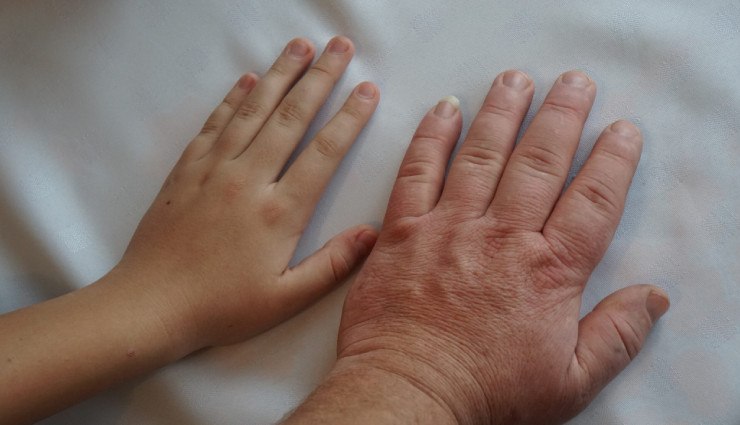Acromegaly is a rare but severe disease caused by a high growth hormone in the body. Approximately 3 to 14 people out of every 100,000 suffer from this disease. This disease affects the bones and tissues of the body and causes abnormal growth after puberty. Surgery, drug therapy, and radiation therapy are the most common treatments for this disease. Do you know why acromegaly happens and what complications and therapy it has? To learn more about this disease, stay with us until the end of the article.
What is acromegaly?
The pituitary gland is a small, pea-like endocrine gland located at the brain’s base under the hypothalamus and secretes eight critical hormones, including growth hormone (GH). Growth hormone or somatotropin is a natural hormone that affects children’s growth by affecting different body parts. By closing the growth plates (epiphysis) in the bones, instead of increasing height, growth hormone helps maintain the structure of bones and cartilage and organs, metabolism, and regular blood sugar. If an adult has too much growth hormone in the body, this can cause abnormal bone shape, increased organ size, blood sugar levels, and other symptoms.
Cause of acromegaly
The most common cause of acromegaly is non-cancerous tumors in the pituitary gland (pituitary adenoma), which causes acromegaly by producing excess growth hormone. These tumors usually grow slowly, and the person does not notice the symptoms of the disease for years. According to the size and location of the cancer, the adenoma can pressure the pituitary tissue and affect the production of other pituitary hormones. If the adenoma is large, it can affect other parts of the brain and cause headaches and vision problems.
This disease is not hereditary in most cases, and usually, adenoma occurs spontaneously due to genetic changes. Sometimes tumors develop in other body parts, such as the lungs, pancreas, or other parts of the brain, which may be related to genetic diseases.
Symptoms of acromegaly
Acromegaly in adults causes an increase in the size of bones, cartilage, and other tissues and organs of the body. Specific appearance changes include the enlargement of hands, feet, ears, lips, nose, tongue, jaw, and forehead prominence.
The growth hormone also signals the liver to produce insulin-like growth factor-1 (IGF-1). This hormone, which causes bone and body tissue growth, also affects how blood sugar and lipids are processed. An increase in the amount of growth hormone causes an increase in insulin-like growth factor 1, which may lead to type 2 diabetes, increased blood sugar, and heart disease.
Early symptoms of acromegaly
- Swelling of the hands and feet, such as a narrowing of a ring or an increase in the size of a shoe;
- fatigue or trouble sleeping;
- The gradual change in face shape;
- Hand numbness or weakness.
Other symptoms of acromegaly
- excessive sweating or oily skin;
- hoarseness of voice;
- decreased sexual desire ;
- Irregular menstruation (in women) or ejaculation problems (in men);
- headache ;
- joint pain;
- change in vision;
- sleep apnea ;
- Carpal tunnel syndrome or spinal cord problems.
Complications of acromegaly
Untreated acromegaly can change the shape and appearance of the bone. This issue can affect your image of yourself and your quality of life. Acromegaly has other complications, including:
- type 2 diabetes ;
- high blood pressure ;
- heart disease ;
- Cardiomyopathy (heart muscle disease);
- arthritis ;
- Colon polyps that can turn into colon cancer if not treated ;
- organ failure
Diagnosis of acromegaly

Symptoms of acromegaly usually appear slowly over several years, making diagnosis difficult. Your doctor may refer you to an endocrinologist who diagnoses hormone-related diseases. This disease is diagnosed by reviewing the medical history, clinical evaluation, and performing specific tests.
Acromegaly diagnosis test
- blood test ;
- glucose tolerance test;
- Brain scans such as MRI or CT scans.
Diagnosis of complications of acromegaly
If acromegaly is diagnosed, the doctor may perform additional tests to check the effect of the disease on other parts of the body, including:
- echocardiogram to prevent heart problems;
- sleep test to check for sleep apnea;
- colonoscopy to evaluate the colon;
- X-ray or DEXA to check bone health.
Treatment of acromegaly
Acromegaly can be treated in some cases. There are several treatment options for acromegaly. Considering the symptoms and condition of the person, the doctor suggests the best treatment option. The treatment consists of several parts:
- reducing the production of growth hormone to an average amount;
- removal of tumor pressure on surrounding tissues;
- Treatment of any hormone deficiency;
- improvement of symptoms.
1. Acromegaly surgery
In many cases, surgery will significantly reduce the symptoms of the disease or completely cure the disease. Depending on the size and location of the tumor, the surgery is different, and the goal is to delete cancer. Transsphenoidal surgery is usually used, during which the doctor reaches the desired location through the nose and sphenoid sinus. If the tumor is removed enough, no other treatment is needed. Still, if only part of the tumor is removed, it may be necessary to use drugs or radiation therapy to control the disease or reduce the production of growth hormones.
Risk of surgery
- damage to the healthy parts of the pituitary gland;
- Cerebrospinal fluid leakage;
- Meningitis (rare).
2. Medication for acromegaly
A doctor may prescribe a drug or a combination of drugs. Medicines control growth hormone levels and improve symptoms in different ways. In some cases, the person uses the mixture until the tumor shrinks. This helps the surgeon to remove the safety cancer. But some people must take medicine to suppress growth hormones and symptoms for the rest of their lives.
There are three different types of medicine for this condition:
- Monthly injections of octreotide, lanreotide, or parotid reduce growth hormone secretion and sometimes shrink the tumor.
- Daily injection of Pegozomant inhibits growth hormone’s effect and improves symptoms.
- Bromocriptine or cabergoline tablets stop the production of growth hormones. (This drug only works on a small number of people.)
3. Radiotherapy
Radiation therapy is used if complete or partial removal of the tumor and the use of drugs are ineffective. This work gradually reduces the growth hormone, but its effect is not permanent, and medicine should be used.
There are two types of radiation therapy for acromegaly:
- Stereotactic radiation therapy: high-dose radiation is injected into the adenoma. This method is more common for adenoma treatment. It shrinks the tumor, and the risk of damage to the surrounding tissues is less.
- Traditional radiation therapy: In this cheaper method, trim and more expansive doses of radiation are injected into the adenoma in 4 to 6 weeks, and in the meantime, the tissue is given a chance to repair.
Radiation therapy may have the following side effects:
- Decreased production of other hormones (requirement of hormone replacement therapy);
- Negative impact on fertility.
Prevention of acromegaly
Unfortunately, there is no way to prevent acromegaly. Also, the cause of pituitary tumors and the development of acromegaly is still unknown, but genetic factors may play a role in this issue.
The difference between gigantism and acromegaly
Acromegaly and gigantism are the same diseases caused by increased growth hormone, with the difference that this disease is called acromegaly in adults and gigantism in children. In short, the difference between acromegaly and gigantism is in these cases:
- Gigantism occurs when excess growth hormone is produced before the bone plates close (before the end of puberty ), resulting in excessive height. Gigantism is rarer than acromegaly and is sometimes called pediatric acromegaly.
- When the growth plates close, excess growth hormone causes acromegaly. In this case, the height does not increase, but the extra hormone affects the shape of the bones, the size of the organs, and the person’s health.
you say
How familiar are you with acromegaly? Do you know someone who has this disease? If you wish, you can write us your experience and opinion in the comments section and share this article with your friends through social networks.
Warning! This article is only for educational purposes; to use it, it is necessary to consult a doctor or specialist.



